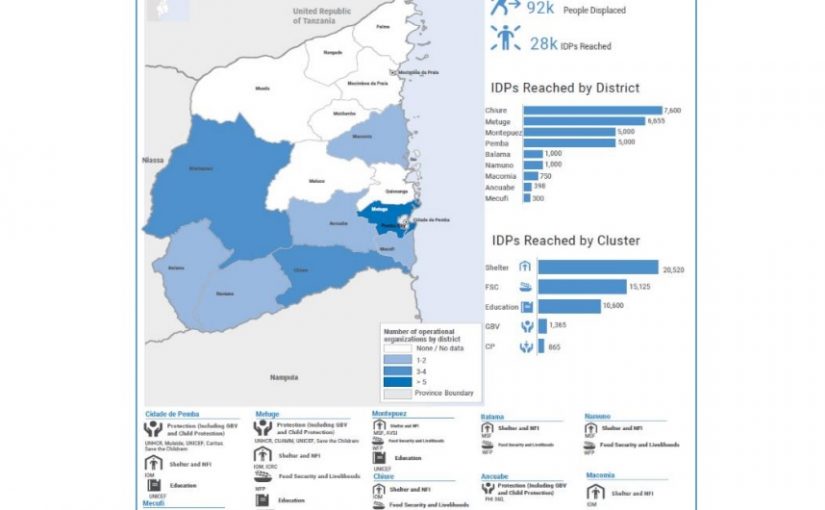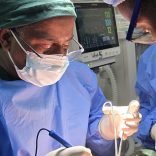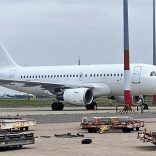Mozambique: Minister joins surgical team to participate in a thyroidectomy
Mozambique: Displacement in Cabo Delgado and Nampula, Situation Report No. 1

People assisted by location and cluster. Source: OCHA
This report is produced by OCHA Mozambique in collaboration with humanitarian partners. It is issued on 22 July 2022. It
covers the period from 1 June to 21 July 2022.
Highlights
- Since June 83,983 people were displaced by attacks in Ancuabe and Chiure districts. The majority of people displaced, approximately 67,524 people, are women and children.
- Violence had a spill-over effect in Nampula province where 23,000 displaced people arrived. However, the vast majority already returned to Cabo Delgado.
- Multisectoral assistance has been provided to approx. 29,000 people in southern Cabo Delgado.
- Humanitarian partners are scaling up response activities to reach all newly displaced people. Additionally, preparedness efforts to respond to potential new caseloads are ongoing.
- The Mozambique Humanitarian Response Plan (HRP) seeks U$ 388.5 million to support 1.2 million people. As of 22 July, the plan is 18 percent funded, having received US$ 73 million. Low level of funding is reported across all clusters.
83,983 People displaced by violence
67,524 Women and children displaced
29,000 People assisted
Situation overview
In June, an uptick of attacks in Ancuabe and Chiure districts triggered significant population movement. According to IOM/DTM, 83,983 people were displaced in June, the majority of whom are women and children (67,524). As many as 69,031 of the movements recorded are individuals who were displaced for the first time. Some 23,774 people were also displaced to Nampula province as result of the attacks, however, the vast majority already returned to Cabo Delgado. Main destinations of arrivals were Pemba and Chiure districts as well as pre-existing IDPs’ sites across Ancuabe, Chiure and Metuge districts.
In Ancuabe district where 32,000 people were displaced by violence or fear of violence, the Camp Coordination and Camp Management (CCCM) Cluster has conducted a mapping of critical needs in 29 sites of displacement. The CCCM cluster reports than an estimated 33 per cent of the newly arrived population requires shelter assistance, 23 per cent requires food assistance, 13 per cent requires access to water, and the remaining 31 per cent requires access to other needs like latrines and hygiene kits.
The government and site service providers have been upgrading five sites as transit centers with a capacity of 7,000 people to accommodate the newly displaced. The sites are in Metuge (Unidade 2 and Centro de Nacuta) and Chiure (Nacivare, Ocua, and Megaruma). Site service providers are actively involved in site coordination and monitoring including tracking and validating new arrivals, identifying available shelters at sites and mapping service provision.
Given the deteriorating humanitarian situation in southern Cabo Delgado, the humanitarian community has been gearing up to respond to new influxes through flexible modalities while striving to integrate thenew caseloads into regular programmes. To date, approx. 29,000 IDPs have received assistance. The majority of the people were assisted in Chiure, Metuge and Montepuez.
In Pemba, where the arrival of 12,364 displaced people (including 6,128 children) adds up to the to the existing caseload of 139,566 IDPs (highest caseload in Cabo Delgado), authorities have requested the support of the humanitarian community to relocate newly displaced people from Pemba to two areas identified for the establishment of new resettlement sites – N’naua (Metoro administrative post) and Nanona (Mesa administrative post), Ancuabe district. On 5 July, a joint Government and inter-agency assessment mission was conducted to the two identified sites, to review their capacity. The mission found that 1,000 people could be accommodated in the site of Nanona.
The humanitarian community is collaborating with provincial authorities to upgrade Nanona site to receive displaced people. Humanitarians are coordinating with local authorities ‘go and see visits’ by IDPs to Nanona site and other areas in an effort to ensure access to information to IDPs and their inclusion in decision-making processes. Moreover, humanitarians are currently mapping existing sites with land plots available across southern Cabo Delgado that could accommodate newly displaced people. Meanwhile efforts are being made to provide basic humanitarian assistance in Pemba.
An intention survey of people who were recently displaced from Ancuabe to Pemba was conducted on 11 July by the Pemba Administration and protection partners in three neighbourhoods of Pemba (Eduardo Mondlane, Chuiba and Cariaco). In total, 82 IDPs were interviewed. The survey’s results indicated that 22 per cent of the IDPs interviewed want to return to Ancuabe or the place of their habitual residence while the majority expressed different intentions, such as be relocated to another place outside of Pemba (34 per cent), remain in Pemba (23 per cent), or are undecided if they want to move away from Pemba or to another location (11 per cent) due to the lack of information. The remaining 10 per cent expressed that they prefer to be relocated in other place except from their place of origin, if the place to transfer is suitable and safe and they can grow crops. Results demonstrated a need to: 1) ensure better information sharing with the impacted population to ensure informed decision (few had information on upcoming plans); 2) the need to advocate for more options for IDPs (since some wanted to remain in Pemba and others be re-located to sites other than Ancuabe) and 3) advocate for greater protection support to vulnerable displaced people in Pemba.
Humanitarian partners are scaling up activities to reach all people displaced. Additionally, considering the latest trends of attacks and displacement, preparedness efforts to respond to an additional caseload of 50,000 people displaced are ongoing.













Leave a Reply
Be the First to Comment!
You must be logged in to post a comment.
You must be logged in to post a comment.